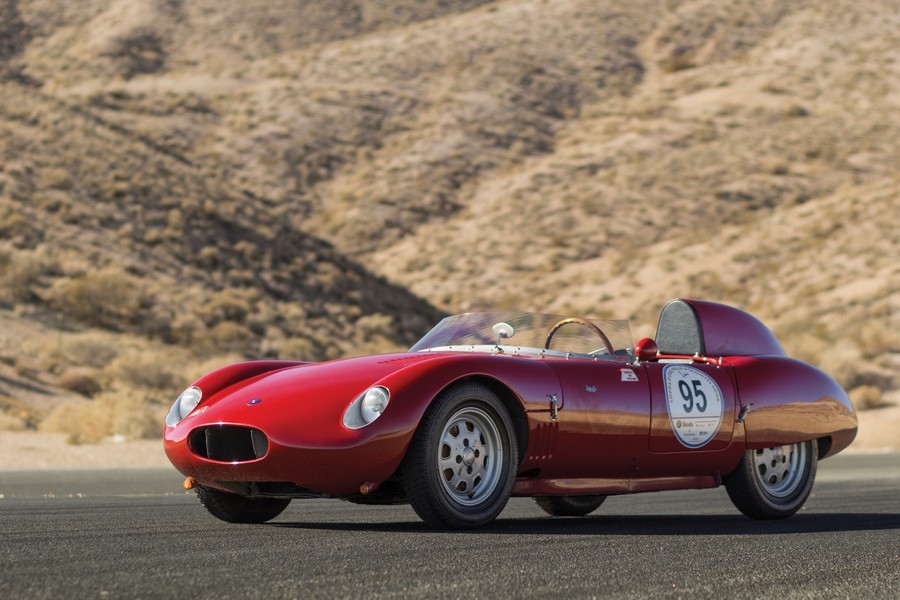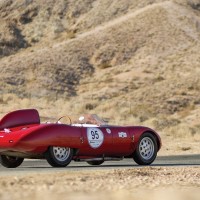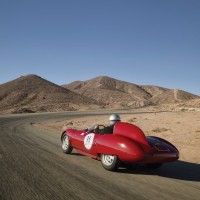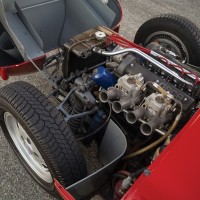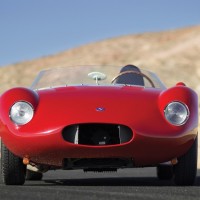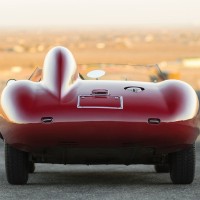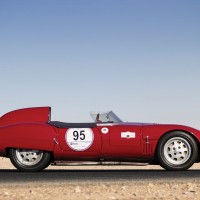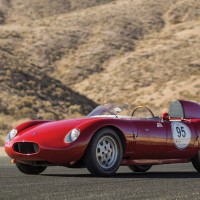After the company’s inception, OSCA quickly began to make a name for itself, as it started to notch up class and overall wins at race tracks all over the globe, with some of the best drivers and teams in the world behind these fantastic new racing machines from Italy. In what is considered to be one of the biggest upsets in the history of endurance racing, Stirling Moss and Bill Lloyd won the 1954 12 Hours of Sebring overall behind the wheel of an OSCA MT4 that was entered by Briggs Cunningham. The duo successfully defeated legendary drivers, such as Phil Hill, Alberto Ascari and Juan Manuel Fangio, and four OSCAs would finish in the top 10. One can only assume that this stunning performance caught the attention of John Bentley, of New York City, who finished 20th in that race in a Siata Fiat. Bentley purchased the OSCA 750 S presented here new in 1960.
After it was purchased, chassis 769, the last of its kind to be produced by OSCA, immediately began its career on the racetrack, with both its co-owners, John Bentley and John “Jack” Gordon, behind the wheel. Both Bentley and Gordon were intimately familiar with OSCA automobiles, as they had campaigned a similar model at the 1960 24 Hours of Le Mans, finishing an incredible 2nd in class and 18th overall. Away from the race track, Gordon was a rocket scientist, proving that his aspirations for speed weren’t just limited to machines with four wheels and that he had the requisite technical know-how to keep a car like this in race-winning mechanical condition.
The car’s first major competitive outing would be the 1960 12 Hours of Sebring. Bentley and Gordon decided to cut holes in the nose of the car to mount additional headlamps. After a hard-fought 12 hours of racing, the OSCA screamed across the line in 12th place overall and 1st in its class and also won the Index of Performance.
Saying that this OSCA had a successful career following the 1960 12 Hours of Sebring would be an understatement, as chassis 769 won its class at many a race in the upcoming years. Gordon raced the OSCA at tracks all over the East Coast of the United States. In 1962, the OSCA returned to the 12 Hours of Sebring, where Bentley and Gordon placed 23rd overall and 1st in class once more. Accumulating so many victories led Gordon not only to the SCCA Northeast Division Championships but also to the SCCA National Championships.
By the end of Gordon’s ownership of OSCA 769, he had secured numerous podium finishes in his class, including claiming the Northeast Division title in 1963 and finishing 2nd in the championship in 1961, 1962, and 1964. Gordon and his OSCA proved to be just as successful in the SCCA National Championships for the same class, finishing 2nd in 1961, 1962 and 1964, and 3rd in 1963.
Gordon sold his OSCA in 1966 to Roger Clouser of Rochester, NY. It then had two subsequent owners in North Carolina and Illinois. The car was then purchased, in a partially restored state, by a David DuBrul in 1983. DuBrul continued the restoration, and it was completed the following year. After being returned to its original state, with its nose returned to its original form, the OSCA was fitted with Weber 33DS carburetors from engine 773, and it emerged more than ready to return to the track.
In June 1986, this OSCA was purchased from David DuBrul in Burlington, VT, by Oliver Collins, an enthusiastic vintage racer, and the car was a frequent sight at VSCCA events on a variety of tracks in the Northeastern United States and Canada. Most notably, the car won and set a course record for cars with under 1 liter of displacement, which was a record that it would hold for seven years. Collins sold the car in 2005, after over 20 years of racing and ownership, and it has been very well looked after in the collection of its current owner since.
SCM Analysis
Detailing
| Vehicle: | 1960 OSCA 750 S |
| Number Produced: | 17 |
| Original List Price: | $2,720 (L4,000,000) |
| Tune Up Cost: | $450 |
| Distributor Caps: | $35 |
| Chassis Number Location: | Engine compartment on firewall |
| Engine Number Location: | N/A |
| Club Info: | Maserati Club International |
| Website: | http://www.maseratinet.com |
| Investment Grade: | A |
This car, Lot 27, sold for $660,000, including buyer’s premium, at RM Auctions’ sale in Phoenix, AZ, on January 16, 2014.
One has to wonder if the Maserati brothers offended some ancient gods in previous lives. The cars built by the company that bears their name have been highly praised and underappreciated (read: undervalued) for years. If you agree on that point, then the cars they built carrying the OSCA badge following their departure from their eponymous Modenese firm suffer even more so.
Small, fast cars
Once again free from the need to think about road cars, at OSCA the Maserati brothers turned their genius full force onto the circuits and road courses of the world, concentrating on the kind of small-displacement cars they loved best. Almost without exception, OSCAs performed brilliantly in competition, whether driven by the leading professionals or well-to-do amateurs. As a result, they have an enviable record in both international championship events as well as all levels of club racing on three continents.
Most are clothed in attractive bodies, generally built by the unsung carrozzerie of Italy, such as Motto or Morelli. Easy to drive, they flatter the merely adequate driver — such as myself — with their balance of power, chassis and suspension, while allowing the truly talented pilot a great deal of fun along with absolutely crushing the competition. With a few exceptions, these car are also inexpensive to run and maintain, provided you don’t put it dirty-side-up too often and have a bit of respect for rev limits.
Getting tubular
Our subject car was a lovely example of one of the prettiest OSCA 750-cc cars, a small car with a big-car look. This Tipo S-187N — or second series model — has the advantage of the fully hinged hood/fender design, which makes engine maintenance far easier than in the first series (Tipo S-187). When built, the Tipo S-187 earned the nickname “Toothpaste Tube” for the way the front and rear tapered down and inwards, resembling the standard Italian toothpaste container of the time.
Speaking of tubes, the prototype S-187 also had a remarkable chassis structure, consisting of a labyrinth of small-diameter tubes. It was said to be unique in Italian construction, a bit like a cross between the triangulated chassis of the Maserati Birdcage and Carrozzeria Touring’s Superleggera technique. However, it proved too costly to produce, and the remaining cars reverted to a more traditional chassis of large-diameter tubes.
Living provenance
More than with any other type of car, originality and history become of vital importance when it comes to competition cars — especially small-displacement Italian cars. This OSCA had an uninterrupted ownership history, with several of the owners still on the right side of the grass. As such, ownership claims can be fairly easily resolved and historical details confirmed. For a car such as this, knowing its whereabouts from new is more important than a file full of records listing a large number of former owners who are now conveniently deceased.
Because cars such as this are easily reproduced, an expert’s inspection and report are important to a prudent buy. There is nothing quite like the sinking feeling one might get when a letter arrives from the organizers of a major international event that a car with the same chassis number as yours has already been accepted and Sir Stirling Moss or some other luminary is driving it. While it’s certainly not unusual to have engines changed in these cars due to wear, damage or a desire to run in different competition classes, the one slightly odd thing about this OSCA’s description is the story of the engine numbers.
The chassis plate bears the number of the current engine 769N, which according to the catalog description, is the second engine fitted to the car. In most circumstances that would be a red flag of the highest order. It is said that 769N was ordered as a spare from new and installed a year later — enlarged to 850 cc — while engine 774N first ran in the car. It seems more likely that 769N was delivered with the car and removed for the upgrade, with 774N having been ordered as a spare. As 774 and 769 do not appear in lists of engine numbers for any other cars, this is almost certainly the case.
A bargain at this price
This car was very well finished, as befits these cars. Although simpler than many of their contemporaries, the cars produced by Maserati, including their race cars, generally were finished better than their counterparts. While I didn’t go through every inch, the frame welds appeared to be consistent with period work, which is very important for determining both structural condition and originality.
The price achieved for this car doesn’t seem particularly low by absolute dollars for an under-1-liter car, but when you look at the provenance, condition, usability and event eligibility, the value becomes more plainly apparent. That this car was not driven by star drivers makes the price even more impressive. This is a case where the brothers Maserati received their due — but these cars are still bargains. ♦
(Introductory description courtesy of RM Auctions.)
